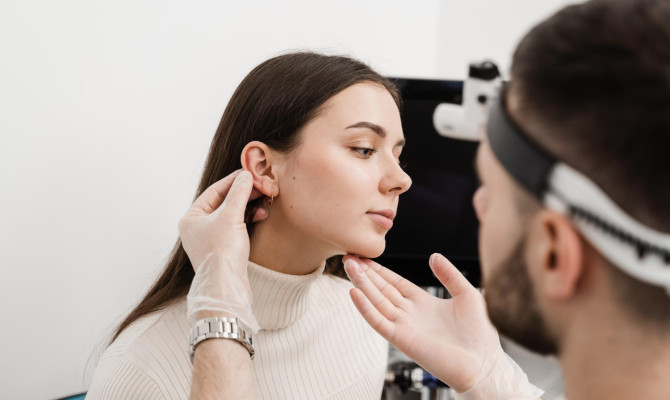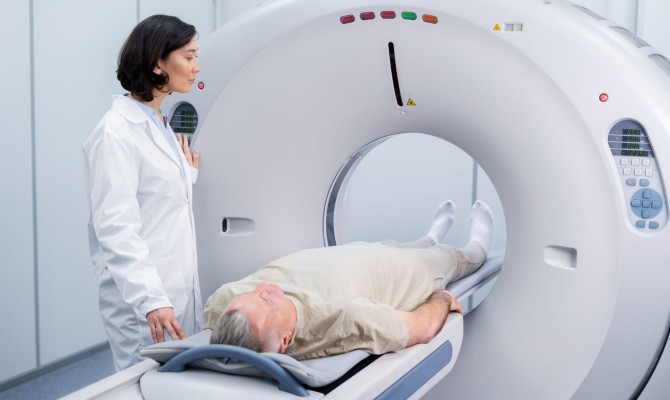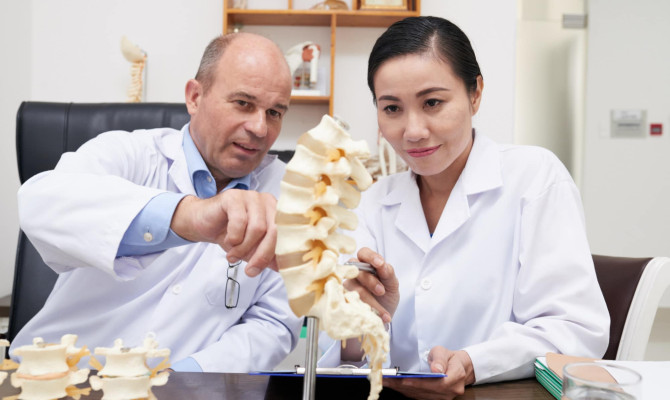Rheumatoid Arthritis: Understanding and Management

- Rheumatoid Arthritis
- 25 Aug 2023
Overview
Introduction
Rheumatoid arthritis (RA) is a type of arthritis that results in inflammation and discomfort in the joints. It occurs when there is malfunctioning of the immune system which later targets the lining of the joints – synovium. The same joints on either side of the body are affected by it. The ankles, knees, and hands are usually affected. But occasionally, the eyes, circulatory system, and respiratory system are also affected by RA. RA is more commonly seen in females than in males and it is typically seen in middle life. Chronic pain, deformity, and loss of balance might all result in rheumatoid arthritis. 1Chronic pain | Deformity | Researched based study from Arthritis Foundation

Signs & Symptoms
Signs and symptoms of Rheumatoid Arthritis:
Often, the condition develops gradually. Early signs could include:
- Joint pain
- Weight loss
- Fever
- Joint swelling and stiffness
- Fatigue
- Weakness
- Limited range of motion
Other signs include –
- Pleurisy-related chest pain while breathing
- Mouth and eye dryness – Sjogren syndrome
- Gum infections in the mouth
- Redness of the eye, and infection
- Impaired vision, and sensitivity to light
- Eye discharge, stinging, and burning sensation
- Nodules under the skin (usually indicate a more severe illness)
- Burning, and tingling sensation, or numbness in extremities
- Shortness of breath
- Sleep issues 3Sign and Symptoms| Researched based study from MedlinePlus
Causes
Causes of Rheumatoid Arthritis:
- In healthy humans, the immune system defends the body against external substances such as various viruses and bacteria.
- The immune system of a person diagnosed with rheumatoid arthritis misidentifies the body’s cells as foreign particles. As a result, they release inflammatory chemicals which hence attack the unidentified cells.
- The synovium and the tissue that lines the joint secretes a fluid that helps the joint for its smooth motion is attacked in RA.
- The sensitive, red, and swollen area of the joint is because of the thickening of the inflammatory synovium, which makes moving the joint challenging.
- The causes of RA are unknown. People might have particular genes brought on by any environmental triggers. They can also be brought on by emotional or physical stress, bacteria, virus, or any other factor. 2Causes of Rheumatoid Arthritis| Researched based study from Centers for Disease Control and Prevention
Risk Factors
Risk factors for Rheumatoid Arthritis:
Researchers have studied various genetic and environmental factors to find out if they affect a person’s chance of having RA. Risk factors include:
- Age – Although RA can start at any age, the chance rises with advancing years. Adults in their 60s have had greater incidence of RA onset.
- Sex – Women often have two to three times as many new instances of RA as men do.
- Genetic factor – RA is more prone to occur in those born with particular genes or those with a family history of the disease.
- Smoking- Smoking increases the chances of a person getting RA and can make the condition worse, according to numerous studies.
- Birth History – RA risk may be higher in women who have never given birth.
- Childhood Exposures – Some early life experiences may make it more likely that an adult may acquire RA. For instance, children whose mothers smoked had a doubled incidence of adult RA.
- Socio-economic Conditions – Adult RA development is more likely to occur in children of lower-income parents.
- Obesity – A person’s risk of acquiring RA increases with increasing weight. 2Risk Factors | Researched based study from Centers for Disease Control and Prevention
Diagnosis
Diagnosis of Rheumatoid Arthritis:
The first step to successfully treating RA is to receive a correct diagnosis as soon as possible. The best person to make a precise diagnosis is a doctor with specific expertise in treating arthritis, referred to as a rheumatologist.
- Medical Background – The physician will inquire about joint soreness, stiffness, pain, difficulty moving, and when they begin, if the symptoms come and go, the severity of the symptoms, what actions improve or aggravate the symptoms, and whether any family history of RA or any another autoimmune disease.
- Physical Examination – The doctor will search for lumps under the skin, swelling, joint pain, redness, soreness, and movements.
There is no specific test to identify RA. However, the following two laboratory tests frequently aid in the diagnosis and are generally positive in patients:
- Rheumatoid Factor: An elevated (CRP) C-reactive protein and erythrocyte sedimentation rate (ESR) along with additional RA diagnostic indicators, aid in diagnosing RA.
- Antibodies against the CCP: Rheumatoid factor (RF) is an antibody eventually detected in roughly 80 % of RA patients. In 60 to 70 percent of RA patients, antibodies to (CCP) cyclic citrullinated peptides are detected. 3Diagnosis of Rheumatoid Arthritis| Researched based study from MedlinePlus
Additional tests that could be performed include:
- CBC (complete blood count)
- Metabolic panel and C-reactive protein (CRP) for uric acid
- ESR (erythrocyte sedimentation rate)
- Antibodies against nuclei
- Hepatitis testing
- X-rays of the joints
- Joint fluid analysis using MRI or joint ultrasound 1Diagnosis of Rheumatoid Arthritis | Researched based study from Arthritis Foundation
Treatment
Treatment of Rheumatoid Arthritis:
Most frequently, RA necessitates long-term care from a rheumatologist. Stopping the progression of RA is the aim of treatment and may include:
Medicines:
Anti-Inflammatory Medications:
- Anti-inflammatory medications include Aspirin, Ibuprofen, Celecoxib, and Naproxen.
- Although these medications effectively reduce edema and inflammation in joints, they may also cause long-term adverse effects.
- As a result, they should, whenever feasible, only be used for a brief period and in small quantities.
Disease-modifying antirheumatic medications (DMARDs):
- DMARDs should be administered along with anti-inflammatory drugs because, when taken alone, they cannot stop joint deterioration. 3Treatment of Rheumatoid Arthritis | Researched based study from MedlinePlus
- Patients taking DMARDs with anti-inflammatory drugs are also advised to do strengthening exercises and rest.
- The most popular DMARDS for rheumatoid arthritis is Methotrexate. Other options include leflunomide and hydroxychloroquine.
- Drugs methotrexate and hydroxychloroquine are frequently used with sulfasalazine to form triple therapy. 3Treatment of Rheumatoid Arthritis| Researched based study from MedlinePlus
Corticosteroids:
- These drugs effectively reduce edema and inflammation in joints, but they have potential long-term adverse effects and, when used alone, do not shield joints against injury.
- As a result, they should, whenever feasible, only be used for a brief period and in small quantities.rheumatoid arthritis 3Treatment of Rheumatoid Arthritis | Researched based study from MedlinePlus
Antimalarial Drugs:
- Malaria-prevention drugs – A member of this class of medications is hydroxychloroquine (Plaquenil). 3Antimalarial Drugs | Researched based study from MedlinePlus
Physical Therapy:
- Routine exercises and range-of-motion exercises suggested by a physical therapist can help to keep muscles strong and improve joint function.
- To lessen discomfort and improve joint movement, therapists occasionally employ specialized machines to deliver deep heat or electrical stimulation.
Additional treatments that could lessen joint pain include:
- Joint defense strategies.
- Cold and heat therapies.
- Devices to support and align joints, such as splints or orthotics.
- Frequently taking a break between tasks and getting a minimum of 8 to 10 hours of sleep each night.
Surgery:
For severely injured joints to be repaired, surgery may be required. Surgery could involve:
- Joint lining removal (synovectomy).
- In severe cases, total hip and knee replacement surgery could be performed.
Nutrition:
- Some persons who suffer from RA might be food intolerant or allergic.
- It is advised to eat a healthful, balanced diet.
- Consuming foods high in fish oils (omega-3 fatty acids) may be beneficial.
- Alcohol in excess should also be avoided.
Home Remedies

Home remedies:
Numerous daily activities, such as work, social interactions, and quality time are affected by RA. Fortunately, the neighborhood offers a variety of low-cost strategies that can help to improve quality of life.
- Adults should ideally practice 100 to 150 minutes of moderate physical activity every week. They can spend half an hour per day riding a bicycle, swimming, and walking.
- Additionally, regular exercise can decrease the chances of developing other chronic conditions.
- Depression, respiratory illness, anxiety, diabetes, and heart disease all can be improved. 1Home remedies| Researched based study from Arthritis Foundation
Attend Programs:
- Attend programs which help people to encourage physical activity.
- Participating in physical activity programs can help in reducing pain and disability that is caused by RA and enhance physical movements and mood.
- Classes are held in the parks and community centers in the area.
Quit Smoking:
- Smoking cigarettes is very harmful and it can worsen RA and lead to other health issues.
- Additionally, smoking might make it more difficult to maintain an active lifestyle, which is important for controlling RA.
Continue to Eat Healthy:
- Maintaining a healthy weight is extremely important for persons with RA. Being obese can lead to many complications. 2Eat Healthy | Researched based study from Centers for Disease Control and Prevention
Hot and Cold Therapies:
- The heat therapies that include warm baths and heating pads can ease the sore muscles.
- Cold therapy is recommended for severe discomfort and swollen joints. It can reduce inflammation and numb soreness.
Topical Medicines:
- Topical medicines like stick-on patches, lotions, and gels can reduce joint and muscular pain.
- Some topical medications irritate the nerves to divert the pain. Some people use pills-like medications.
Reducing Stress and Using Complementary Therapies:
- There are various techniques to unwind and divert attention from discomfort.
- They include mindfulness practices such as meditation, deep breathing, and visualizing joyful thoughts.
- Massage therapy can relieve stress, soothe aching muscles, and lessen discomfort.
Supplements:
- Taking supplements containing omega-3 fish oil and turmeric may reduce the pain and stiffness associated with rheumatoid arthritis.
- To address adverse effects and potential interactions with other medications, consult a doctor before beginning any supplementation program. 1Supplements of Rheumatoid Arthritis| Researched based study from Centers for Disease Control and Prevention
Complications
Complications of Rheumatoid Arthritis:
The physical and social effects of rheumatoid arthritis (RA) are extensive and can also affect the quality of life. Pain, incapacity, and early demise are all potential effects.
- The chance of developing other chronic diseases, including diabetes and heart disease, is also elevated in people with RA.
Obesity:
- Obese people with RA are more likely to acquire risk factors for heart disease, diabetes, high blood pressure, and cholesterol, and they also gain less from their medical treatment than the ones with RA who are not obese. 2Obesity | Researched based study from Centers for Disease Control and Prevention
Employment:
- Many RA patients discover they cannot do as much as they could do once the disease worsens.
- People who have jobs with fewer physical demands of jobs, they may control the pace and activities of their workday and experience less work loss. 2Employment | Researched based study from Centers for Disease Control and Prevention
Prognosis
Prognosis of Rheumatoid Arthritis:
Rheumatoid arthritis is a chronic condition that worsens over time and is linked to morbidity and a higher mortality rate. All people will have several exacerbations, and those who do not get treatment usually have poor results like disability and higher mortality rates. Other chronic medical illnesses or consequences that patients with RA experience significantly negatively impact their prognosis. The severity of the symptoms and the person’s response to treatment will determine the prognosis. Starting the treatment as soon as feasible is crucial and stops joint deterioration and discomfort. Without the proper care, a joint injury could become permanent. 4Prognosis of Rheumatoid Arthritis | Researched based study from National Institutes of Health
Any feedback on this article?
 This Articles content was accurate
This Articles content was accurate Very Informative Article
Very Informative Article I have a question or a comment
I have a question or a comment
 This article contains inaccurate content
This article contains inaccurate content This article was not helpful
This article was not helpful I have a question or a comment
I have a question or a comment
We appreciate your helpful feedback!
Checkout our social pages
References
-
Arthritis Foundation
Chronic pain | Deformity | Home remedies
-
Centers for Disease Control and Prevention
Causes of Rheumatoid Arthritis | Risk Factors | Eat Healthy | Supplements of Rheumatoid Arthritis | Obesity | Employment
-
MedlinePlus
Sign and Symptoms | Diagnosis of Rheumatoid Arthritis | Treatment of Rheumatoid Arthritis | Antimalarial Drugs
-
National Institutes of Health
Prognosis of Rheumatoid Arthritis




































